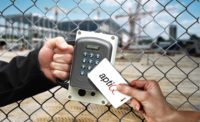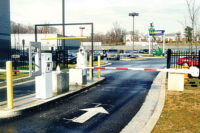Not every integrator has the will, the resources or the knowledge to include parking and gate control as part of their suite of offerings. A few choose to dabble in it when necessary, farming out the tougher revenue jobs to companies that specialize in that. Others have discovered that once you know what you are doing there is a lot of money to be made in parking control.
Gate control as part of an access control system for employees is something many integrators will face, whether they are simply interfacing to it or installing gates and operators themselves. But it can get tricky.
As much as you need to know to put security on a door, there are even more variables when it comes to parking, says Dan Budinoff, president, Security Specialists, Stamford, Conn. “Knowing the appropriate distances from card reader to gate is one. Are there trucks and cars using the same gate so that you need a reader both high and low? There is a lot of knowing code and specific applications.”
Christopher Archer, president and chief executive officer (CEO), Associated Time and Parking Controls, Dallas, says it can be harder than it looks. “We have worked on many occasions with companies who do building access and they say, ‘Oh, it’s just parking.’ But parking has a completely different set of criteria. Revenue is usually the cut-off point for them. We have had to go in and take care of situations where general integrators have tried to get in and do parking revenue and it is not what they expected.”
The process of designing, selling, installing and servicing parking and gate equipment is not without its pitfalls. To read some of the problems integrators have come across in the field,” read “Lessons Learned Designing, Selling, Installing & Servicing Parking & Gate Equipment,” at SDMmag.com.
One of the unique things about parking is that virtually every installation is custom. There is no “cookie cutter” approach, and knowing how to specify, design and sell is the key to a successful installation.
The process of designing, selling, installing and servicing parking and gate equipment is not without its pitfalls. Here are some of the problems integrators have come across in the field.
Sales and Design
One of the biggest challenges for an integrator can be the way the customers themselves operate and what they want out of parking or gate control.
“They all think they operate in the ‘standard’ manner,” says Jack DeMao, CEO, Electric Guard Dog, LLC, Columbia, S.C. “It is standard — for them. But the way they want to interact with the gate and their security system depends on a lot of factors. What is their normal pattern? Do they have two or three trucks trying to get in at the same time? Is their driveway long enough so a truck or vehicle towing a trailer can hit the keypad without leaving the back half sitting out on the road or do they need some automated way to open the gate? These things all affect the design of the system.”
It is all about the consultative sale, adds L. Michael Givens, president, ITR of Georgia Inc., Tucker, Ga. “We talk through that process and start from drawings and make sure we are aware of the environment including overhead clearance, width of lanes and traffic flow. By taking that time we can define and engineer a system that will truly meet their needs as well as provide additional components that they might not have even thought of.”
Michael Kielbasa, security division manager, MidCo Inc., Burr Ridge, Ill., stresses the need to get as much information up front as possible. “Before the design phase, get 100 percent of what the requirements are from all parties and all system interfaces. Then configure the systems, equipment and controls. If you wait until after the fact, that is when extra costs and finger pointing come in.”
Because of the intensive fact finding and design aspect, the sales cycle for parking and gate projects can be long, but it doesn’t have to be. One of the best ways to minimize time, hassle and aggravation for the sales and design teams is to standardize as much as possible, despite the custom nature of the project.
DeMao is very proactive in trying to standardize the process of sales and design. “We used to send a skilled technician to the site who would then design a system and send it back to me. I realized we were wasting money designing situations we weren’t going to implement. We came up with three or four key cost parameters including length of fence, number of gates, number of zones and other critical factors and developed a program that allows our salespeople to do a cost estimate within a few minutes.”
Anything you can make repeatable will help. Givens’ company developed a spreadsheet. “By using those templates and through experience we know pretty well how long a typical installation should take and having that helps us make sure the numbers we are putting together are accurate.”
Consistency is key, says Scott Roether, vice president of TEM Systems Inc., Sunrise, Fla. “When dealing with equipment everything has idiosyncrasies, but we give our salespeople a price book of products we know works. We are a 57-year-old company with a ton of experience. Guys help each other out on projects.”
Many integrators agree that when it comes to gates and parking, under bidding is not the way to go. “We don’t plan to be the low guy,” Givens adds. “We plan to provide a system the customer can count on. It is worth it to us to design the front end of it as carefully as we can, even within general parameters.”
Environment & the Installation
When it comes to the installation portion of the job, the design work done up front really pays off. But there are still some issues that may come up that will affect the installation.
Whether the installation is a parking lot or garage, the clearance from the street and the type of vehicles is critical to know about in advance. Some of these factors are static and must be worked around.
“The lanes and distance off the street are determined by the building or layout of the lot itself,” says Neal Marcus, account manager, Mountain Parking Equipment, Denver. “Given the choice we would like to have a three-car-length distance between the gate and the sidewalk, but that is not always possible.”
Sometimes it is the simple things that get overlooked. “If people are leaving on bicycles, how are they going to get out of the gate?” asks David Chritton, senior systems engineer, Microbiz Security Company, San Francisco.
Another important factor to consider is the physical environment the lot or garage is located in. Are there extremes in temperature? Salt in the air?
“Since we install all over the country we can hit strange terrain problems,” DeMao says. “In areas that get a lot of rain the ground can be soupy or very soft. A normal installation isn’t going to work.”
Environment is important to consider for the installer as well, Budinoff adds. “We are in the Northeast. It is hot in summer and cold in winter. Hot isn’t so bad, but my field guys work at half speed when it is 20 degrees outside. It takes a lot longer and you can’t put the loops into the ground. You have to put a visible sensor in until you install the loops. If I know it is going in the winter, labor costs will be higher.”
Service and Training
Gates and operators in particular are not an “install it and leave for good” item. In addition to missing out on income from service contracts, the customer will be dissatisfied when it breaks down due to wear and tear. Training the users on how to get the most out of their parking system is also crucial to customer satisfaction.
Almost all integrators offer a standard warranty. Beyond that, most choose to offer a variety of service plans in the hopes that the customer will at least do minimum maintenance.
“Gate operators can be out there for easily 15 years, provided they are maintained properly,” Roether says. “Some people are very consistent with it but others don’t see the value and would rather run the risk. We also offer a preventative maintenance inspection if they don’t want to go with a full service plan. We tell them, ‘Don’t do nothing.’”
DeMao builds service into the sale of the system. “We found that if we charged for service, the customer would delay calling and wouldn’t have the right protection and their satisfaction wouldn’t be as high. When we provide it at no additional charge, they end up happier.”
Archer says he is starting to see more interest in maintenance, particularly from revenue parking structures. “They don’t want those systems down because dollars go out the window.”
A happy customer is the key to a successful business in parking and gate control, Roether adds. “It is a great business. Take care of your customer and you are going to be around.”
Standards Versus ‘Best Practices’
As in much of the security industry there are fewer real standards to go by than “best practices” or learn by experience. There are some things to keep in mind, however.
Ground Loops – There are guidelines for where the buried loops should go in relation to the gate, but even the manufacturer’s diagrams don’t tell you all you need to know.
“I see too many people not doing it properly or they don’t have the expertise to cut a loop into the ground,” says Dan Budinoff, Security Specialists. “There is some magic to where you put things and how they are spaced. Even if you look at the manuals that come with the equipment, they are not too specific. They don’t tell you that if you don’t put the loop far enough out from the gate arm and a car pulls out, the gate could come down on the car. Those are things you learn with experience.”
Safety – Gates are heavy. They can injure a person or damage a car. UL 325 is the standard for gate and gate operator safety.
“In some places it is enforced and in many places it isn’t,” says Scott Roether, TEM Systems. “There is always a debate that you could get sued if something happens and you aren’t UL 325 compliant. But if you are more expensive because of it you may not get the work.”
Conduits – Electricians sometimes try to cut corners by asking the integrator to combine high and low voltage wires in one conduit.
“Every gate has both, high voltage for the gate operator and low voltage for the readers and intercoms,” says David Chritton, Microbiz Security Company. “The conduits have to be separate. Often the electrician will ask to put them in one, but the answer is always no. Code also says you have to have 40 percent room in addition to what you put in there so you need to size the conduit properly.”
Certifications – Depending on the state, these are sometimes required and other times not.
“Most states you have to be a low voltage electrical contractor,” Roether adds. “You may need to be considered a fence contractor. Some places enforce it and others don’t.”










